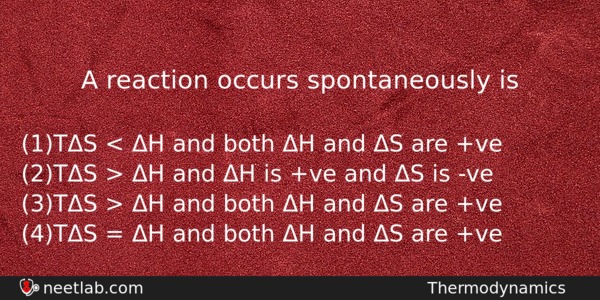| ⇦ | 
| ⇨ |
A reaction occurs spontaneously is
Options
(a) TΔS < ΔH and both ΔH and ΔS are +ve
(b) TΔS > ΔH and ΔH is +ve and ΔS is -ve
(c) TΔS > ΔH and both ΔH and ΔS are +ve
(d) TΔS = ΔH and both ΔH and ΔS are +ve
Correct Answer:
TΔS > ΔH and both ΔH and ΔS are +ve
Explanation:
ΔG = ΔH – TΔS .
ΔG = -ve for spontaneous reaction , When ΔS = +ve, ΔH = +ve and TΔS > ΔH ⇒ ΔG = -ve, When randomness favours and energy factor do not favour then spontaneity depends upon the temperature dependent means at high temperature. TΔS > ΔH, ΔG = -ve and reaction is feasible.
Related Questions: - Anomalous behaviour of nitrogen is due to
- In the reaction : 4Fe + 3O₂ ⇌ 4Fe³⁺ + 6O₂²⁻. Which of the following
- Geometrical isomers differ in
- I₄O₉ is a/an
- Which one of the following reagents will be able to distinguish between 1-butyne
Topics: Thermodynamics
(179)
Subject: Chemistry
(2512)
Important MCQs Based on Medical Entrance Examinations To Improve Your NEET Score
- Anomalous behaviour of nitrogen is due to
- In the reaction : 4Fe + 3O₂ ⇌ 4Fe³⁺ + 6O₂²⁻. Which of the following
- Geometrical isomers differ in
- I₄O₉ is a/an
- Which one of the following reagents will be able to distinguish between 1-butyne
Topics: Thermodynamics (179)
Subject: Chemistry (2512)
Important MCQs Based on Medical Entrance Examinations To Improve Your NEET Score
18000+ students are using NEETLab to improve their score. What about you?
Solve Previous Year MCQs, Mock Tests, Topicwise Practice Tests, Identify Weak Topics, Formula Flash cards and much more is available in NEETLab Android App to improve your NEET score.
Share this page with your friends

Leave a Reply